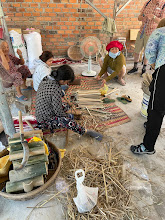TRANSPORTATION CYCLO-SHAWS,
SCOOTERS AND TRAIN STREET
The history of Vietnam can
be as complicated as crossing a street in Hanoi, where the traffic hurtles
through intersections seemingly without regard to traffic signals or personal
or pedestrian safety. Yet, the company we are traveling with Overseas Adventure
Travel (OAT) has made this trip easy. Though they touch on the darker periods of
Vietnam they are not weighed down by the enormity of the past and instead focus
on the warm embracing people who seem genuinely happy that we are visiting
their country.  |
| Sampan along the Mekong |
We are constantly
thrust into the midst of the Vietnamese. We do not emerge from the hermetic
seal of our tour bus only to pause long enough for a kodak moment before piling
back onto the bus. No, we have been given several opportunities to engage and
converse and understand Vietnam and her people.
At times these
opportunities have been harrowing as we have gotten quite up close and personal
with the aforementioned traffic with several novel modes of transportation arranged
for us by OAT. Some of the travel can be superfluous, or deemed less efficient than a tour bus, but every single "chariot" listed here served to enhance our travels throughout the length of Vietnam.
HANOI
Think of a bicycle
pushing a trough in which a passenger sits like an offering to the horsepower gods.
Admittedly this is a very touristy mode of transportation, but the bus dropped
us off where all the “rickshaw” type vehicles were waiting, and we tootled
through the crammed frenetic streets of the old quarter of Hanoi to reach a restaurant
for our welcoming dinner. Crossing the street had been an eye-opening
experience, but the cyclo-shaws put us in the middle of traffic which at times
were a mere few inches from our knees. Slower than the rest of the traffic,
scooters, cars, trucks and buses swirled around us like we were standing still.
Later, in Hoi An, a UNESCO World Heritage city, known for lanterns, the Japanese
Bridge and rampant tourism, the cyclo-shaws barreled swiftly through the
pedestrian traffic.
A ferry
A big part of traveling
with OAT is immersing us with the locals and on their “A Day In The Life” excursion
in North Vietnam was to have us purchase goods at a local market and then take
them to the village elder so they could prepare a lunch for us. Getting to the
village meant we had to cross a river by ferry. No more than a sheet of metal
propelled by a motor we clamored onto the craft along with a scooter or two to traverse
the waterway.
Soviet-era motorcycles
At first, I was worried
about getting on the back of a chortling motorcycle driven by students eager to
practice their English on us. Nevertheless, I rallied and put on my ill-fitting
helmet and tucked in behind my driver and cracked nervous jokes about losing my
life. He laughed and said I was very funny. Heck, I even paid for
this as this was an extra excursion and cost us $70usd each. The motorcycles
moved a lot quicker than the shaws and they took us all over Hanoi. At one
point it started drizzling and we put on plastic ponchos that in the humid night
caused the sweat to pour.
We caromed through the
streets passing Uncle Ho’s mausoleum lit dramatically in the night. We barreled
through dark alley ways that were difficult to negotiate on foot. We entered
the forest that hedged the city and churned along the dirt roads dodging joggers,
pedestrians and for a time trailed behind a Soviet-era jeep laden with tourists
from another group.
Finally giving my butt
a rest we stopped first at the Black Market, where all things were for sale,
from electronics to machine parts to a market of all sorts of animals ready for
the kitchen, including snakes and dogs. Then we stopped for a long time at the
reason why we were so interested in this excursion: Railroad Street.
Railroad Street
After the reunification
of the country Vietnam decided to reunite both halves by building a railroad connecting
the two. The tracks go right through neighborhoods and the trains pass within
inches of patrons willing to sit right at the edge. We had heard of Railroad
Street before we arrived in Vietnam, and it was a number one priority for us.
You don’t need to book a tour to visit this oddly perverse attraction, but
logistics made this a better choice for us. Dinner was included.
HA LONG BAY
Junk boat
Another must do when
visiting Vietnam is Ha Long Bay. This UNESCO World Heritage site is dotted with
over 1,000 limestone islands rising dramatically out of the waters of the bay. After
boarding a tender that brought us to our ship we weaved through the islands and we spent a glorious night on the water. |
| Ha Long Bay |
At first glimpse the
boat looked spartan, but our staterooms were comfortable. On the final morning Janet
joined a class in Tai Chi, with the idyllic limestone cliffs rising beautifully all
around the boat.
We were fortunate as
sometimes weather prevents visitors into the bay.
HUE
Dragon Boat Ride on the Perfume River
We spent two days in this
city that was the scene of vicious fighting during the Tet Offensive. Save for
the Citadel that is still scarred from the fighting Hue is vibrant lively and youthful
and the bars brim with revelers. We toured the Citadel that has slowly been renovated,
but our only extra trip was a Dragon Boat ride on the Perfume River.  |
| Dragon Boat on the Perfume River |
There are
a lot of boats for hire and OAT arranged a ride for us. Our tour bus took us
out to a historic pagoda on the outskirts of Hue and the double hulled boat
plied the river on the way back to town.
HOI AN
Sunset cruise along the
Thu Bon
During our next stop in
this very touristed UNESCO World Heritage site, we would take taxis, and multi-passenger golf carts from our Silk Hotel location to the city center several times over three days for sight seeing and shopping. I had an Aloha shirt made for me, Janet bought some jewelry and some decorative lanterns. Whenever taking a taxi here make sure you negotiate the price before accepting the ride. Don't be afraid to haggle.
 |
| Hoi An street scene |
Hoi An was once a major maritime port for the Silk Road and a commercial hub for European, Chinese and Japanese merchants, and these influences remain in the old city's buildings and structures like the Japanese bridge (which is the city's logo), her religious influences (there is a large Chinese temple in town) and her cuisine (be sure to order a sandwich at Bahn Mi Phu'o'ng).
We also took a hotel shuttle to the Silk Hotel's private beach club to spend half the day swimming the East Sea (formerly called the South China Sea), but the transportation highlight of our stay in Hoi An was an extra cost excursion honchoed by our tour guide Mai.
Our group
cobbled together funds and hired a boat to glide along the Thu Bon River to
capture the sunset and join a parade of festively lighted boats. The colorful lanterns
and lights on the passing ships and on the shore made for one of the most
serene, enchanting nights on our trip to Vietnam. |
| Hoi An |
Near the end of our
boat ride, we each were given floating candles to float on the river and to
make a wish.
NHA TRANG
Scooters
On the outskirts of this
very touristed beach town very popular with Russian and Chinese tourists is a
community of formerly South Vietnamese who went through a reeducation school run
by the victors of the “American War”.
We were each partnered up with a member
of that community so we could ride on their scooter to see how life is like in
the southern version of “A Day In The Life” excursion run by OAT. The traffic
was non-existent compared to Hanoi, and the scooters were roomier and more
comfortable than the motorcycles we rode in Hanoi. At one point we rode
over a ramshackle wooden bridge with several loose planks, but it was all much
less fearsome than the motorcycles. Still, I was glad the bus came for the
return to Nha Trang.
DALAT
Tractor |
| Dalat flower farm |
As part of our day-long
excursion while staying at this city in the highlands of Vietnam we visited a
flower farm and a coffee plantation that specializes in Weasel-shit coffee (yes
that’s a highly prized cup of coffee) and the Banana Village populated by the
hill tribe people of the area. At one point the bus dropped us off we all piled onto a tractor for a rough and tumble
ride along the dirt tracks. Coffee plants and banana trees hedged the dusty
road and we visited with the village elder, a Catholic church and we tried to crash
a lively wedding.
The tractor was
entirely superfluous as our bus later met us at the village and drove back
along the same road, but the ride was fun. The excursion was an extra cost.
HO CHI MINH CITY
Junk boat and Sampan
and TukTuk
Once called Saigon,
with the name change coming after the reunification of the country. It used to
be expressly taboo to refer to this very cosmopolitan city by its original name, but that “rule”
has eased a lot since the United States lifted the trade embargo on Vietnam in 1994.
One day we traveled by
bus to the Mekong River to board a junk and glide past fish traps and visit a farm, where our
hosts treated us to fruit and Banana liquor. Next ,we were given classic
conical hats to wear for a ride in a classic wooden Sampan. Riding low in the murky
brown water we slipped past reeds before reaching a dock and a waiting TukTuk. This ride was a type of flatbed cab with a covering. The driver barreled around
sharp turns on a narrow road that eventually took us to a coconut candy
facility. To help us make purchases of the candy and several other crafts and
artifacts offered for sale we we were given more Banana liquor.
We then rode the junk
back to the waiting bus.
Cu Chi Tunnels
Not quite extra transportation
on our last day in Vietnam we were driven out to visit the Cu Chi Tunnels. Once
the end of the Ho Chi Minh Trail it is now a tourist attraction. Part of the
tour was to climb down into the tunnels and see how the combatants lived. I had
to crawl on my knees to make it in some places.
Vietnam is a long county and included in our trip were several domestic flights, none lasting little more than an hour. We first flew from Hanoi to Hue. From Danang we flew first to Saigon... oops Ho Chi Minh City and connected with a flight to Dalat. After our time in Dalat we flew back to Saigon ... oops Ho Chi Minh City for the last day of our trip to Vietnam.
There’s more to write
about while in Cambodia, but this article is getting too long already. Check
back in later for another entry at Vacations From Home.
Love to all,
Janet and greg
© 2024 by Gregory Dunaj























.jpg)












































